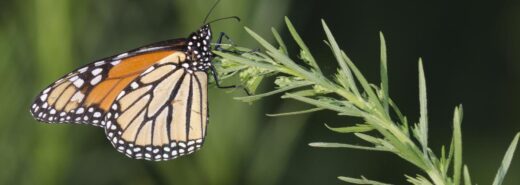In December, the U.S. Fish and Wildlife Service proposed listing the monarch butterfly as a threatened species under section 4(d) of the Endangered Species Act. But that action may be too late for the venerable and beautiful creature.

On Jan. 30, the Xerces Society, which has organized survey counts of the Monarch for the past 28 years, reported that the population count for the Western Monarch was 9.119 – the second lowest during this period.
Only three years ago, the Xerces Monarch census totaled more than 200,000.
“The population’s size is extremely concerning,” said Emma Pelton, an endangered species biologist with Xerces Society for Invertebrate Conservation. “We know small populations are especially vulnerable to environmental fluctuations, and we think that’s what happened this year. The record high late summer temperatures and drought in the West likely contributed to the significant drop-off we saw in the third and fourth breeding generations.”

Scientists note that pesticides, habitat loss and severe weather, attributed to climate change, have all contributed threats to the Monarch’s population.
“Research in California’s Central Valley by the Xerces Society and University of Nevada-Reno found that milkweed leaves – the food source for monarch caterpillars – were contaminated by 64 different pesticides. One of these, called methoxyfenozide, is likely to be highly toxic to caterpillars and was in 96% of milkweed samples, but it is classified as “practically non-toxic” to adult honeybees – the only insect species currently included in testing by the Environmental Protection Agency before a new pesticide is approved for market,” Xerces stated in its press release.
Now, a new threat has occurred according to the Xerces Society. Last month’s Los Angeles County fires burned many acres of tree groves in the Monarch’s winter area along the coast.
The Monarch has had a small habitat homestead on the Hill. For years, it visited and populated the small area around the Pine Cove Water District office. The PCWD area was a registered monarch habitat, according to current PCWD director and former office manager, Becky Smith. And the butterfly has been a very popular visitor to many Nature Center and Earth Fair events on the Hill.
At the Pine Cove Water District October 2021 Board meeting, former General Manager Jerry Holldber reported that the office’s habitat “broke all records. We had close to 150 butterflies.” But similar to the overall Western Monarch population, the Hill visitors have begun to decline. Current PCWD General Manager Jeremy Potter, said only a couple of butterflies were seen and no caterpillars.
The FWS estimated that without help, the Western Monarch probability of extinction is 99% within the next 60 years. This estimate was made before the current census was made and Los Angeles fires occurred.
In 2018, California initiated its own efforts to protect the valued species. The Monarch Butterfly and Pollinator Rescue Program was created by Assembly Bill 2421.
Its purpose is to assist in the recovery and sustaining of monarch butterflies and other pollinators. Grants and technical assistance are available to encourage these actions.
The FWS proposed rule and designation can be found at www.regulations.gov/document/FWS-R3-ES-2024-0137-0001. The public comment period began Dec. 12, 2024 and will conclude March 12.
The FWS encourages online or written comments, which can be submitted to Public Comments Processing, Attn: FWS-R3-ES-2024-0137, U.S. Fish and Wildlife Service, MS: PRB/3W, 5275 Leesburg Pike, Falls Church, VA 22041-3803.
Online comments can be submitted by going first to the Federal eRulemaking Portal: https://www.regulations.gov. In the Search box, enter FWS-R3-ES-2024-0137, which is the docket number for this rulemaking. Then, click on the Search button. On the resulting page, in the panel on the left side of the screen, under the Document Type heading, check the Proposed Rule box to locate this document. You may submit a comment by clicking on “Comment.”
Commenting on the proposal, Isis Howard, coordinator of the Western Monarch Count with the Xerces Society, said in their press release, “A lot of people care about monarchs. Voluntary efforts like pollinator gardens and restoring habitat are probably a reason they aren’t in worse shape. However, these actions are not enough. To help monarchs recover, we need to work at a larger scale and address widespread issues like pesticide contamination and climate change that are beyond what voluntary efforts have been able to achieve.”
For more information about the Monarch listing proposal, and how to help conserve Monarch butterflies, please visit: www.fws.gov/monarch.





